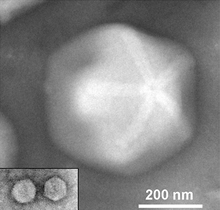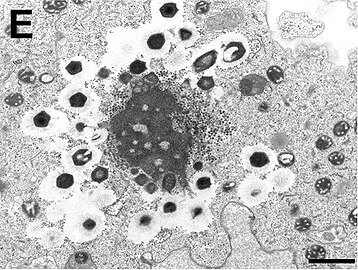Zamilon virophage
| Mimivirus-dependent virus Zamilon | |
|---|---|

| |
| Two Zamilon virophages (inset) to scale with their associated giant virus Megavirus [1] | |
| Virus classification | |
| (unranked): | Virus |
| Realm: | Varidnaviria |
| Kingdom: | Bamfordvirae |
| Phylum: | Preplasmiviricota |
| Class: | Maveriviricetes |
| Order: | Priklausovirales |
| Family: | Lavidaviridae |
| Genus: | Sputnikvirus |
| Species: | Mimivirus-dependent virus Zamilon
|
Mimivirus-dependent virus Zamilon, or Zamilon, is a
All known virophages are associated with helpers in the
Zamilon was discovered in 2013, in
Taxonomy
Zamilon virophage has been classified by the
Virology
A Zamilon virion is spherical with a diameter of 50–60 nm, and is similar in appearance to those of Sputnik and Mavirus.[3] Its circular double-stranded DNA genome is 17,276 base pairs in length.[2][3] Virophages typically have particles whose diameter is in the range 40–80 nm, with genomes in the range 17–30 kb.[2] The virophage most closely related to Zamilon is Sputnik, with which it shares 76% sequence identity, although part of the Zamilon sequence is reversed compared with Sputnik.[2][3] Zamilon's DNA is rich in adenine and thymine bases; the proportion of guanine and cytosine bases is 29.7%.[3]
Open reading frames
The Zamilon genome is predicted to contain 20
| ORF[a] | Predicted size (amino acids) |
Related product | Similarity (%) |
Predicted function |
|---|---|---|---|---|
| 1 | 111 | none | – | – |
| 2 | 73 | none | – | – |
| 3 | 135 | Megavirus chilensis mg3 gene product | 67 | – |
| 4 | 221 | Sputnik virophage 2 putative IS3 family transposase A protein | 40 | putative transposase |
| 5 | 376 | Sputnik virophage 2 minor virion protein | 66 | minor virion protein |
| 6 | 609 | Sputnik virophage capsid protein V20 | 86 | capsid protein |
| 7 | 442 | Sputnik virophage V21 | 70 | – |
| 8 | 81 | Moumouvirus monve hypothetical protein tv_L8 | 72 | – |
| 9 | 778 | Sputnik virophage V13 | 67 | putative helicase |
| 10 | 168 | Sputnik virophage V11 | 53 | – |
| 11 | 247 | Sputnik virophage V10 | 58 | putative integrase |
| 12 | 175 | Sputnik virophage V9 | 77 | – |
| 13 | 184 | Sputnik virophage V8 | 71 | structural protein |
| 14 | 241 | Sputnik virophage V7 | 80 | – |
| 15 | 305 | Sputnik virophage V6 | 75 | collagen-like protein |
| 16 | 121 | Sputnik virophage V5 | 59 | – |
| 17 | 133 | Sputnik virophage V4 | 55 | – |
| 18 | 245 | Sputnik virophage V3 | 81 | DNA-packaging ATPase |
| 19 | 147 | Megavirus chilensis mg664 gene product | 50 | – |
| 20 | 147 | Sputnik virophage V1 | 60 | – |
Life cycle and helper virus
Like all other virophages, Zamilon replicates in the
Zamilon does not appear to inhibit the ability of its helper virus to replicate significantly, nor to
-
virus factory in an amoebaco-infected with Mimivirus-dependent virus Zamilon (small particles) and Mont1. Arrows show abnormal Mont1 particles (scale bar: 0.1 μm)
-
Electron micrograph of virus factory in an amoeba co-infected with Zamilon and Mont1 (scale bar: 0.1 μm)
References
- doi:10.1371/journal.ppat.1007592..
 Material was copied from this source, which is available under a Creative Commons Attribution 4.0 International License
Material was copied from this source, which is available under a Creative Commons Attribution 4.0 International License - ^ PMID 26446887
- ^ PMID 24747414
- S2CID 4382855
- PMID 23298151
- PMID 25909276
- PMID 26640459
- PMID 23091035
- PMID 25104553


